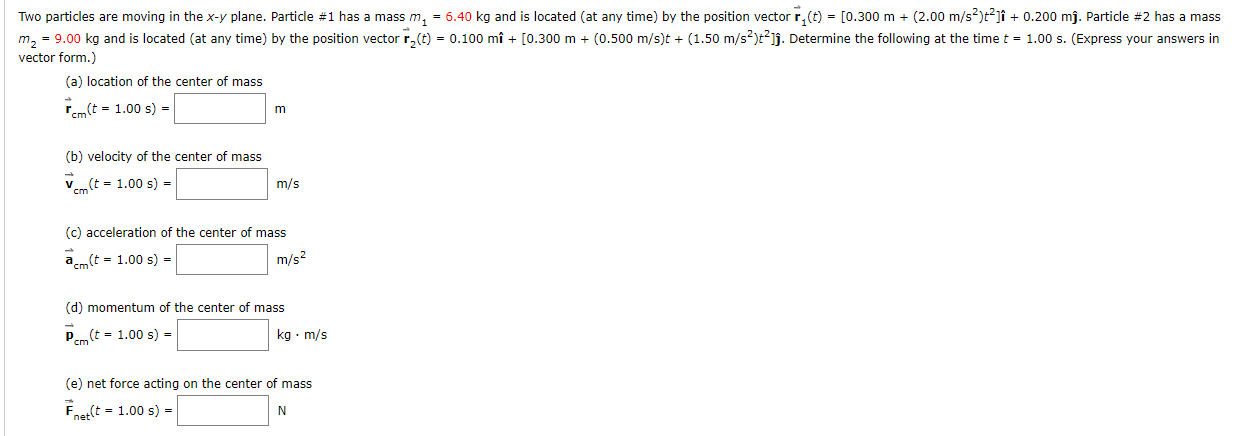Two particles are moving in the x-y plane. Particle #1 has a mass m, = 6.40 kg and is located (at any time) by the position vector r, (t) = [0.300 m + (2.00 m/s?)t?jî + 0.200 mj. Particle #2 has a mass m, = 9.00 kg and is located (at any time) by the position vector r,(t) = 0.100 mî + [0.300 m + (0.500 m/s)t + (1.50 m/s?)t?jj. Determine the following at the time t = 1.00 s. (Express your answers in vector form.) (a) location of the center of mass r(t = 1.00 s) = m (b) velocity of the center of mass Vem (t = 1.00 s) = m/s v (c) acceleration of the center of mass a(t = 1.00 s) = m/s?
Two particles are moving in the x-y plane. Particle #1 has a mass m, = 6.40 kg and is located (at any time) by the position vector r, (t) = [0.300 m + (2.00 m/s?)t?jî + 0.200 mj. Particle #2 has a mass m, = 9.00 kg and is located (at any time) by the position vector r,(t) = 0.100 mî + [0.300 m + (0.500 m/s)t + (1.50 m/s?)t?jj. Determine the following at the time t = 1.00 s. (Express your answers in vector form.) (a) location of the center of mass r(t = 1.00 s) = m (b) velocity of the center of mass Vem (t = 1.00 s) = m/s v (c) acceleration of the center of mass a(t = 1.00 s) = m/s?
Principles of Physics: A Calculus-Based Text
5th Edition
ISBN:9781133104261
Author:Raymond A. Serway, John W. Jewett
Publisher:Raymond A. Serway, John W. Jewett
Chapter8: Momentum And Collisions
Section: Chapter Questions
Problem 31P
Related questions
Topic Video
Question
100%

Transcribed Image Text:Two particles are moving in the x-y plane. Particle #1 has a mass m, = 6.40 kg and is located (at any time) by the position vector r, (t) = [0.300 m + (2.00 m/s?)t?jî + 0.200 mj. Particle #2 has a mass
m, = 9.00 kg and is located (at any time) by the position vector r,(t) = 0.100 mî + [0.300 m + (0.500 m/s)t + (1.50 m/s?)t?jj. Determine the following at the time t = 1.00 s. (Express your answers in
vector form.)
(a) location of the center of mass
r(t = 1.00 s) =
m
(b) velocity of the center of mass
Vem (t = 1.00 s) =
m/s
v
(c) acceleration of the center of mass
a(t = 1.00 s) =
m/s?
Expert Solution
This question has been solved!
Explore an expertly crafted, step-by-step solution for a thorough understanding of key concepts.
This is a popular solution!
Trending now
This is a popular solution!
Step by step
Solved in 5 steps with 4 images

Knowledge Booster
Learn more about
Need a deep-dive on the concept behind this application? Look no further. Learn more about this topic, physics and related others by exploring similar questions and additional content below.Recommended textbooks for you

Principles of Physics: A Calculus-Based Text
Physics
ISBN:
9781133104261
Author:
Raymond A. Serway, John W. Jewett
Publisher:
Cengage Learning

Physics for Scientists and Engineers: Foundations…
Physics
ISBN:
9781133939146
Author:
Katz, Debora M.
Publisher:
Cengage Learning

College Physics
Physics
ISBN:
9781285737027
Author:
Raymond A. Serway, Chris Vuille
Publisher:
Cengage Learning

Principles of Physics: A Calculus-Based Text
Physics
ISBN:
9781133104261
Author:
Raymond A. Serway, John W. Jewett
Publisher:
Cengage Learning

Physics for Scientists and Engineers: Foundations…
Physics
ISBN:
9781133939146
Author:
Katz, Debora M.
Publisher:
Cengage Learning

College Physics
Physics
ISBN:
9781285737027
Author:
Raymond A. Serway, Chris Vuille
Publisher:
Cengage Learning

College Physics
Physics
ISBN:
9781305952300
Author:
Raymond A. Serway, Chris Vuille
Publisher:
Cengage Learning